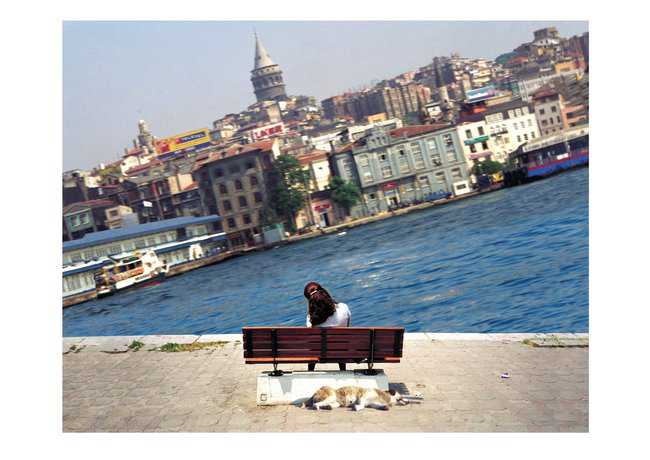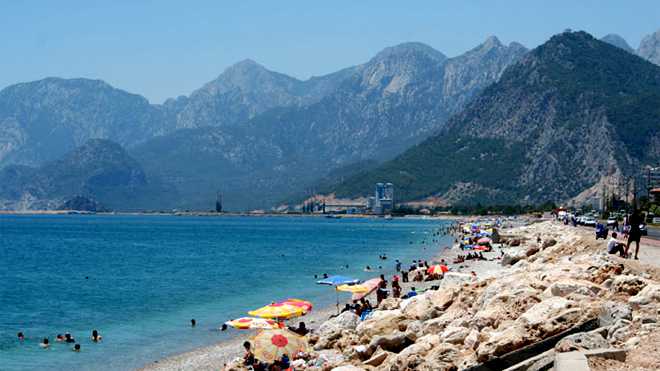Modern Women Artists in Turkey Meet Their Trailblazing Counterparts
By SUSANNE FOWLER
ISTANBUL — “Dream and Reality,” a show at the Istanbul Modern art museum, pairs “nearly forgotten” painters from the Ottoman era with some of the most intriguing artists in Turkey today.
 Courtesy of Aydan Murtezaoglu
Courtesy of Aydan Murtezaoglu
Perceptions of reality are questioned in ‘‘Untitled, 1999’’ a digital photograph of the Galata area of Istanbul by Aydan Murtezaoglu.
The common thread? All are women.
Levent Calikoglu, chief curator for the Modern, said by e-mail last week that female artists “have a very important, critical and pioneering position in the Turkish art world. One of the objectives of the show was to render this visible.”
Another goal, he said, was to illustrate the social and cultural transformation in Turkey over the past century by reintroducing the older painters’ accomplishments alongside the work of contemporary artists who tackle more modern challenges through newer mediums like video.
In 1913, for example, the Newspaper of the Ottoman Painters’ Association wrote that the profession of painting and womanhood had never “agreed with each other.” It argued further that a deep love of art and the “inextinguishable” desire to paint were inherently male attributes.
But toward the end of the Ottoman Empire, daughters of the wealthy or upper-middle class intellectuals, particularly in Istanbul and especially in non-Muslim families, were encouraged to learn to paint, to speak French and to play the piano, Mr. Calikoglu noted, all in an effort to appear more Westernized.
Even so, being an artist was not encouraged as a career track, since society’s main objective for women was to fill roles as wives and mothers.
“Art for women was considered a mere hobby, a pastime,” he said. “Professionally speaking, men monopolized art, just as they did the word ‘genius.”’
This was not the case only in Turkey, of course. “I don’t think the Ottoman society presented a more constraining environment than that experienced by French Impressionist women artists,” Mr. Calikoglu said. “If we consider the examples of Mary Cassatt or Berthe Morisot we can realize how Ottoman and French women artists stood up to similar difficulties” inherent in the social roles assigned to them.
In the 1920s, the Turkish Republic continued to send artists to Europe for study and training, as ambassadors of a sort for the new Turkey. According to the “Dreams” exhibit catalog, when the figurative painter Mihri Musfik, who was born in 1886, traveled to the United States, a Turkish newspaper referred to her 1928 visit as “powerful and effective propaganda in America on behalf of Turkey and the Turks.”
Yet life was hardly easy for such trailblazers. Ms. Musfik had run away from her home in Istanbul in her 20s to go to Rome, and later lived in the Montparnasse area of Paris, selling portraits to earn a living. Her niece Hale Asaf became a painter, and worked in Berlin, Munich and Paris, also finding more of an audience abroad than at home. Ms. Musfik died in the 1950s, impoverished, her portraits already fading from the art world’s collective memory.
“Very little information about the individual life stories of this generation of female artists exists,” Mr. Calikoglu wrote in the exhibit catalog, “and there is no clear and accurate information about the number of their works.”
Even for the most accomplished ones like Ms. Musfik, “female artists are mentioned in the texts of male authors of history in one or two sentences at most,” he wrote.
Fatmagul Berktay, another curator of the “Dream” exhibit, wrote that “Patriarchal ideology assigned men the attributes of rationality, civilization and culture, while the female identity was one of irrationality and sentimentality,” right down to a Turkish proverb that says women are “long of hair, short of sense.”
In Turkey as elsewhere, female artists of the era were mainly confined to becoming teachers of painting, if they had careers at all. And a dearth of documentation — like the paper trails built by the catalogs or biographies common for male artists — led to a number of what Mr. Calikoglu termed “dead ends” for the team of curators mounting this anthology of works by 74 women.
More »
A version of this article appeared in print on December 15, 2011, in The International Herald Tribune with the headline: Modern Women Artists in Turkey Meet Their Trailblazing Counterparts.
via Modern Women Artists in Turkey Meet Their Trailblazing Counterparts – NYTimes.com.

